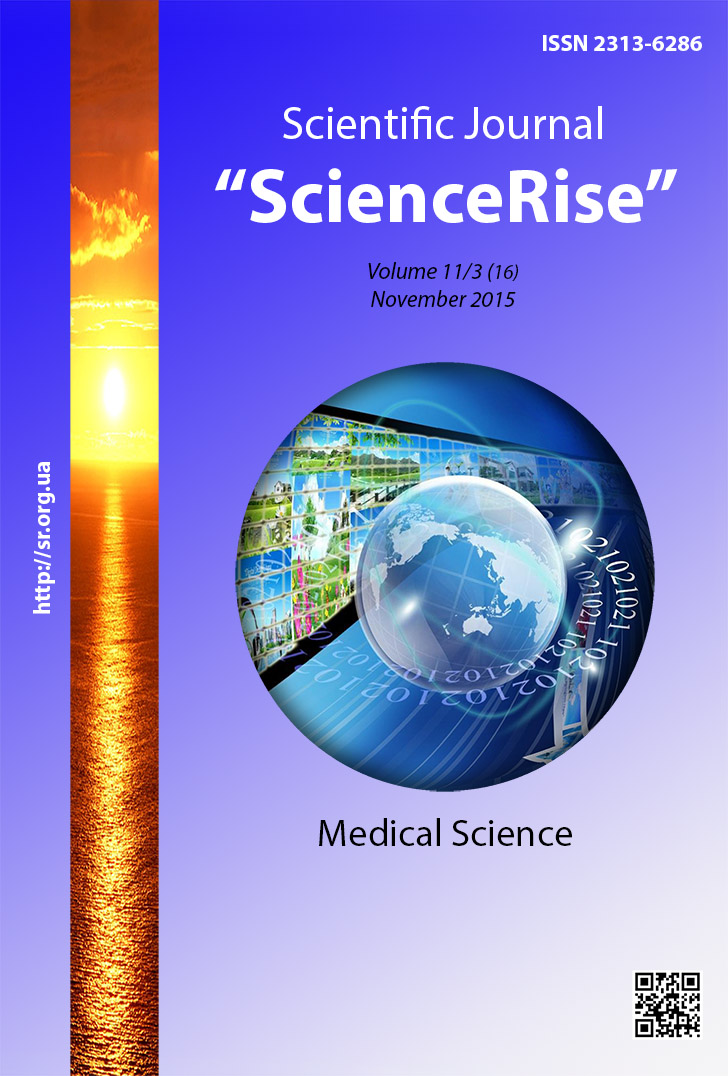Role of beta1-adrenoreceptors at visual associative cortex in rats of different age in the impact on autonomous regulation of the heart rate ander low atmospheric pressure
DOI:
https://doi.org/10.15587/2313-8416.2015.54021Keywords:
beta1-Adrenergic receptors, decreased atmospheric pressure, heart autonomic regulation, associative cortexAbstract
The role of beta1-adrenoreceptors at visual associative cortex in rats of different age in the impact on autonomous regulation of the heart rate ander low atmospheric pressure was investigated. The aim of the study was to check expediency of application nebivolol to prevent the adverse effects of hypoxic environment, the pressure conditions similar to the third type of weather.
Methods. In the experimental group cardiointervalography recorded in the intact condition before hypoxia, after hypoxic exposure, after trepanation of the skull and applying the solution beta1-blocker nebivolol (0.5 mg / kg) through the trepanation hole on the surface of the cerebral cortex (there were separate groups with right-sided and left-sided trepanation in projection of cortical areas Oc2L), with subsequent automatic analysis of data on a personal computer. In the control group a similar procedure of the experiment was carried out excepting hypoxic exposure. Effect of hypoxic atmosphere was created by reducing pressure by 50.76 hPa (0.05 atm) in the Komovsky’s device and hold the anesthetized rat under a glass bell for 1 hour.
Results. In juvenile, adult and old intact rats beta1-receptor structures in left and right associative cortical fields Oc2L are included to the neural circuits that provide growth of functional strenuousness in regulation of heart rhythm. After hypoxic exposure beta1-adrenoreceptors in the left field Oc2L are included in other neural circuits, and take part in limiting the functional strenuousness in regulation of heart rhythm.
Conclusions. Experimental results about effectiveness of therapeutic doses of beta-1 adrenoblockers especially nebivolol in adult and old age for prevention of unfavorable effects of hypoxic medium that corresponds to the baric conditions of 111type weather are to be verified by the clinical observations
References
Ermakova, L. N., Ermakova, E. S. (2012). Influence of meteorological conditions on the well-being. Geographical Journal, 2 (21), 45–52.
Volkova, N. M. (2009). Features of autonomous regulation of mental performance in adverse weather conditions load Bukovina Medical Journal, 13 (2), 16–18.
Volkova, N. M. (2009). The role of autonomous regulation mechanisms of meteotropic reactions in healthy adults. Environment and Health, 1 (48), 18–21.
Anju, T. R., Smijin, S., Chinthu, R., Paulose, C. S. (2012). Decreased cholinergic function in the cerebral cortex of hypoxic neonatal rats: Role of glucose, oxygen and epinephrine resuscitation. Respiratory Physiology & Neurobiology, 180 (1), 8–13. doi: 10.1016/j.resp.2011.08.013
Gliebus, G., Lippa, C. F. (2007). The Influence of beta -Blockers on Delayed Memory Function in People With Cognitive Impairment. American Journal of Alzheimer’s Disease and Other Dementias, 22 (1), 57–61. doi: 10.1177/1533317506295889
Münzel, T., Gori, T. (2009). Nebivolol: the somewhat-different beta-adrenergic receptor blocker. Journal of the American College of Cardiology, 54 (16), 1491–1499. doi: 10.1016/j.jacc.2009.05.066
Kamp, O., Metra, M., Bugatti, S., Bettari, L., Dei Cas, A., Petrini, N., Dei Cas, L. (2010). Nebivolol. Drugs, 70 (1), 41–56. doi: 10.2165/11530710-000000000-00000
Zhao, W., Belayev, L., Ginsberg, M. D. (1997). Transient Middle Cerebral Artery Occlusion by Intraluminal Suture: II. Neurological Deficits, and Pixel-Based Correlation of Histopathology with Local Blood Flow and Glucose Utilization. Journal of Cerebral Blood Flow and Metabolism, 17, 1281–1290. doi: 10.1097/00004647-199712000-00003
Paxinos, G., Watson, Ch. (1997). The rat brain in stereotaxic coordinates. United States of America, 25. Available at: http://www.callisto-science.org/NSI/Neuroscience_Image_Database/PDFFILES/RBSC_INT.PDF
Xi, L., Serebrovskaya, T. V. (2012). Intermittent Hypoxia and Human Diseases. Springer Science & Business Media, 316. London, 316. doi: 10.1007/978-1-4471-2906-6
Korkushko, A. V., Pisaruk, A. V., Shatylo, V. B. (2009). Value analysis of heart rhythm variability in Cardiology. Circulation age aspects and hemostasis,1 (2), 127–139.
Dalmases, M., Torres, M., Márquez-Kisinousky, L. (2014). Brain tissue hypoxia and oxidative stress induced by obstructive apneas is different in young and aged rats. Sleep, 37 (07), 1249–1256. doi: 10.5665/sleep.3848
Storozhuk, V. M. (2009). Role of acetylcholine in modulating the activity of neurons in the neocortex conscious animals in the implementation of instrumental conditioned reflex. Neurophysiology, 41 (2), 144–159.
Rapino, C., Bianchi, G., Di Giulio, C., Centurione, L., Cacchio, M., Antonucci, A., Cataldi, A. (2005). HIF-1alpha cytoplasmic accumulation is associated with cell death in old rat cerebral cortex exposed to intermittent hypoxia. Aging Cell, 4 (4), 177–185. doi: 10.1111/j.1474-9726.2005.00161.x
Uzar, E., Acar, A., Evliyaoğlu, O., Fırat, U., Kamasak, K., Göçmez, C. et. al (2012). The anti-oxidant and anti-apoptotic effects of nebivolol and zofenopril in a model of cerebral ischemia/reperfusion in rats. Progress in Neuro-Psychopharmacology and Biological Psychiatry, 36 (1), 22–28. doi: 10.1016/j.pnpbp.2011.08.011
Fairhall, S. L., Macaluso, E. (2009). Spatial attention can modulate audiovisual integration at multiple cortical and subcortical sites. European Journal of Neuroscience, 29 (6), 1247–1257. doi: 10.1111/j.1460-9568.2009.06688.x
Zito, G. A., Senti, T., Cazzoli, D., Müri, R. M., Mosimann, U. P., Nyffeler, T., Nef, T. (2015). Cathodal HD-tDCS on the right V5 improves motion perception in humans. Frontiers in Behavioral Neuroscience, 9. doi: 10.3389/fnbeh.2015.00257
Downloads
Published
Issue
Section
License
Copyright (c) 2015 Наталія Михайлівна Волкова

This work is licensed under a Creative Commons Attribution 4.0 International License.
Our journal abides by the Creative Commons CC BY copyright rights and permissions for open access journals.
Authors, who are published in this journal, agree to the following conditions:
1. The authors reserve the right to authorship of the work and pass the first publication right of this work to the journal under the terms of a Creative Commons CC BY, which allows others to freely distribute the published research with the obligatory reference to the authors of the original work and the first publication of the work in this journal.
2. The authors have the right to conclude separate supplement agreements that relate to non-exclusive work distribution in the form in which it has been published by the journal (for example, to upload the work to the online storage of the journal or publish it as part of a monograph), provided that the reference to the first publication of the work in this journal is included.

